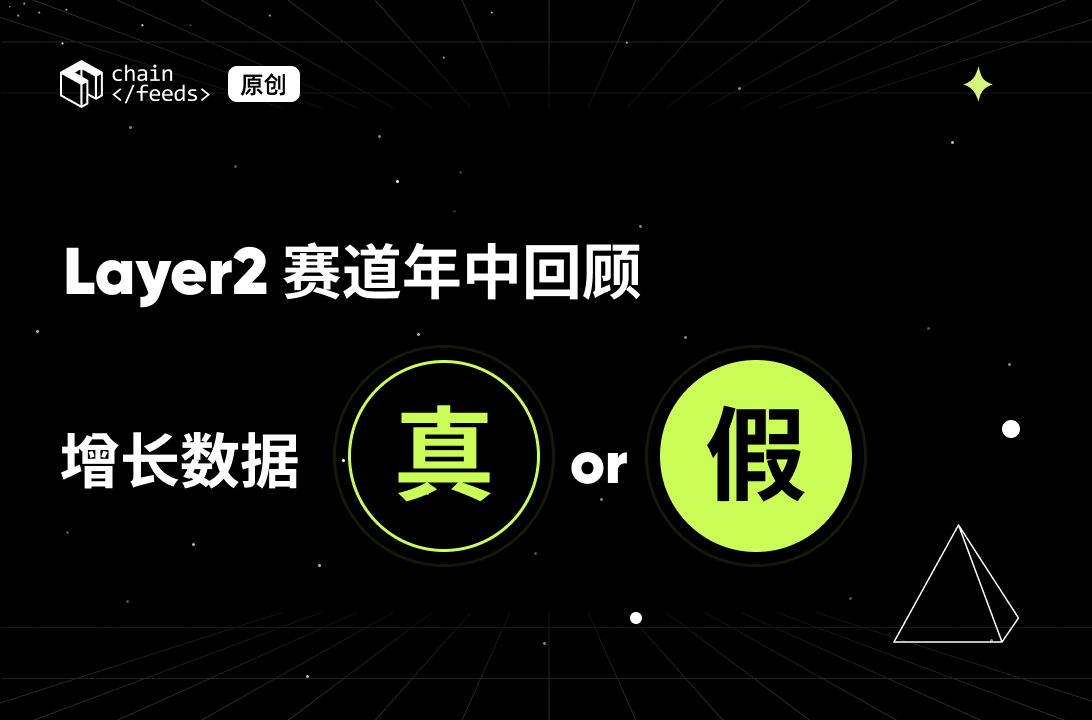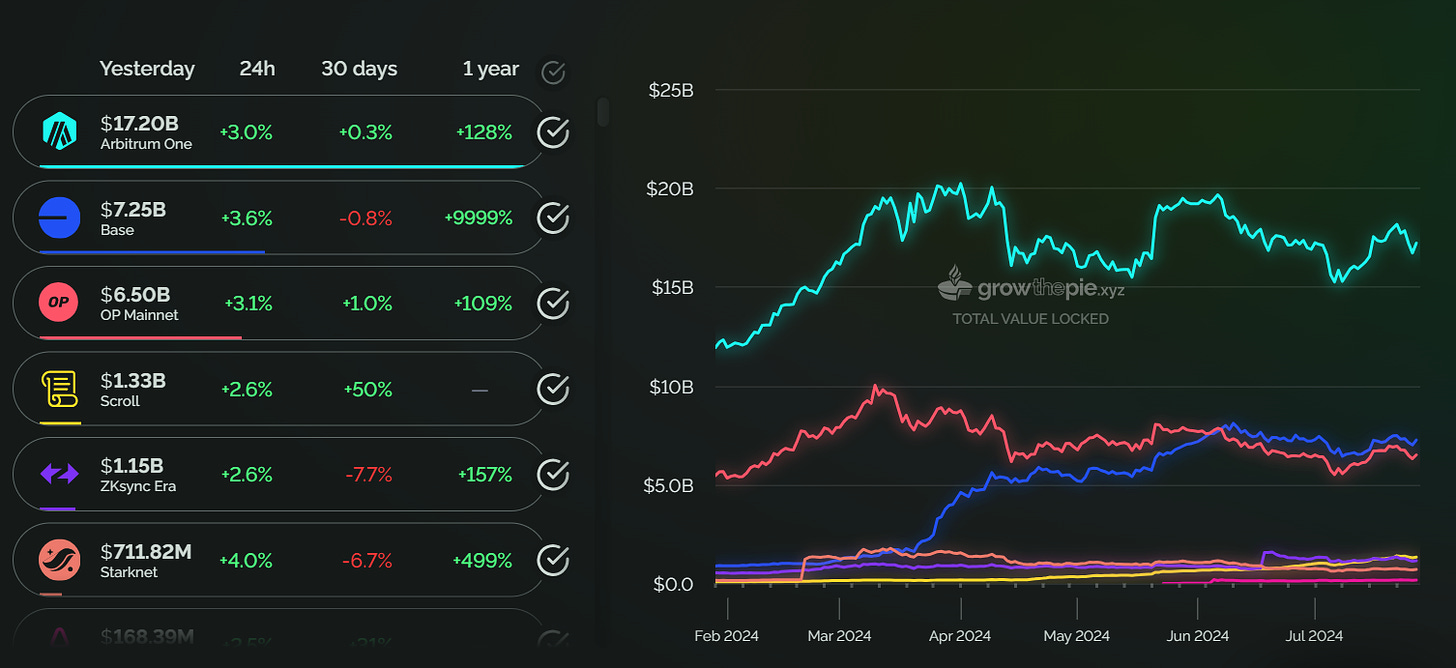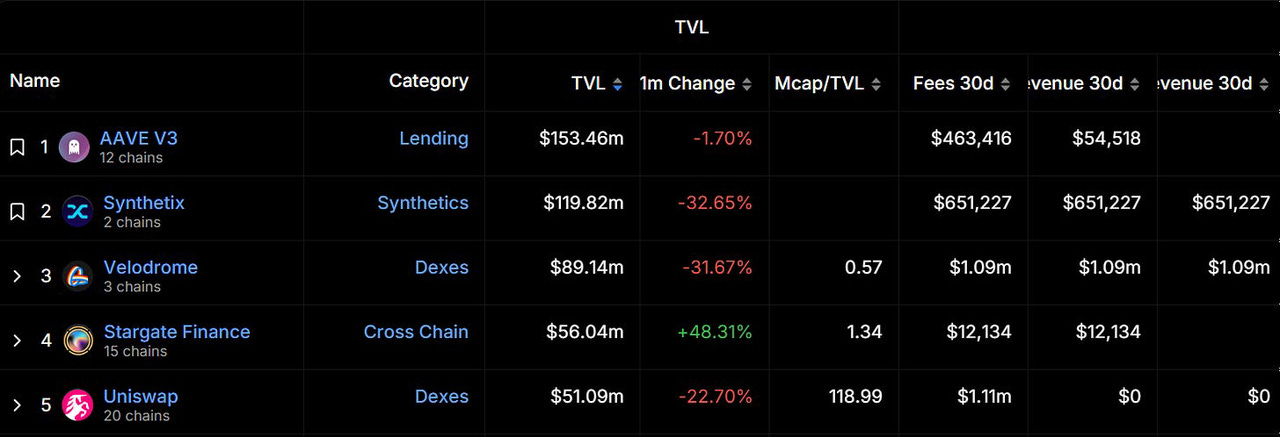Arbitrum, Optimism, zkSync, Starknet, Base, Taiko and Scroll
Author: Linda Bell , ChainFeeds Research

In March 2024, Ethereum completed the Cancun upgrade, bringing attention back to the Layer2 field. At the same time, Starknet and zkSync completed their airdrop plans in the first half of the year, and the four major Layer2 projects have issued tokens. In addition, some new Layer2 projects also performed very well in 2024. For example, Base achieved significant traffic growth in the first half of 2024, surpassing Optimism to become the second largest Layer2.
Although the Layer2 field shows a strong growth trend, the market still has doubts about the authenticity of its data. Previously, zkSync’s daily average transaction volume and number of active addresses have been questioned. So, do these superficial prosperity truly reflect the actual usage of the network?
TL;DR:
- In the first half of 2024, Arbitrum continued to lead the way, with a total locked value of US$17.15 billion, accounting for 40% of the market share, ranking first.
- Base surpassed Optimism with a TVL of $7 billion to become the second largest Layer2 platform. In addition, as of July 28, Base's average daily transaction volume reached 4 million, almost twice that of Arbitrum, and the number of active addresses also exceeded Arbitrum, reaching more than 600,000.
- zkSync's TVL reached $1.12 billion in the first half of 2024, up about 99% from the beginning of the year, but the number of active addresses fell by 83.5% after the airdrop, and the average daily transaction volume also fell by 86%. Similarly, Starknet's TVL fell back to $685 million after reaching an all-time high of $1.776 billion in March, the number of active addresses fell by 92%, and the average daily transaction volume fell by 64.2%.
- Taiko’s mainnet was launched in May 2024, and its TVL reached an all-time high of $190 million on June 5, but then fell back to $163.45 million. The number of active addresses fell 78.3% after the June peak.
- Scroll TVL increased by 1544% year-on-year, but the growth of its number of active addresses and average daily transaction volume was relatively small. The number of active addresses increased by 13.4% from the beginning of the year, and the average daily transaction volume increased by 27.7%.
(The data sources for this article are L2BEAT , growthepie and DeFiLlama )
Total locked value

Arbitrum takes the lead, Base surpasses Optimism to become the second largest Layer2
In the first half of 2024, the total locked value of the Layer2 ecosystem increased from approximately US$22.8 billion at the end of January to US$42.97 billion, an increase of approximately 88%. Among them, Arbitrum, Optimism and Base are the main contributors.
Since the beginning of 2024, Arbitrum's total locked value has remained at the leading level. As of July 28, Arbitrum's TVL reached approximately US$17.15 billion, ranking first, accounting for approximately 40% of the market share, far exceeding the second-ranked Base by more than 2.4 times. According to DeFiLlama data, the project with the highest total locked value on Arbitrum is AAVE, with a locked value of US$812.62 million, followed by GMX and Uniswap, with US$513.89 million and US$325.43 million, respectively.

In addition, as can be seen from the figure below, the total locked value of Arbitrum has shown a downward trend from March to May. The main reason may be that the Arbitrum team and investors unlocked a large number of ARB tokens in March. According to Token Unlocks data, as of July 28, the unlocking progress of ARB is temporarily 34%.

As a rising star, Base has maintained an upward trend since the beginning of 2024, and surpassed Optimism in June to become the second largest Layer2. At present, the total locked value of Base is about 7 billion US dollars, an increase of about 716% from the beginning of the year. As can be seen from the figure below, Base saw a significant increase in TVL in March, which may be due to the continued growth of Farcaster, the reduction of Gas fees after the Cancun upgrade, and the popularity of MEME tokens, which led to a significant increase in on-chain liquidity and promoted the growth of TVL. However, Base's TVL has fallen slightly at present, down about 6.6% from June.

According to DefiLlama data, the current DeFi TVL on Base is $1.67 billion, with native DeFi projects dominating, including Aerodrome ($654 million) and Extra Finance ($110 million). Aerodrome is the dApp with the highest total locked value on the Base chain, more than double the second-ranked Uniswap.

Optimsim currently ranks third in total locked-in volume. It reached its historical high in the first half of the year on March 10, 2024, and then fell back slightly, but was relatively stable overall, and was eventually overtaken by Base in June. According to DeFiLlama data, the top three projects in the Optimism ecosystem TVL are AAVE v3, Synthetix and Velodrome. However, in the past month, the TVL of these projects has shown a downward trend.

Scroll hits new highs, Taiko TVL falls after reaching a historical high
On the other hand, Scroll's total locked value in 2024 has hit new highs, currently reaching $1.3 billion , ranking fourth among the Layer2 selected in this article, with an astonishing increase of 1544%. This growth may be attributed to a series of activities launched by Scroll at the user and developer level. Scroll launched Scroll Sessions in April and launched Session One on June 21, which aims to specifically reward DeFi users who provide liquidity in DEX. In addition, Scroll has launched the "Level Up with Scroll" platform, allowing developers to apply for ecological funding.

According to DeFiLlama data, the project with the highest total locked value on Scroll is its native project Pencils Protocol, with a locked value of $310.87 million, up 317% in the past month. It is worth noting that the total locked value of Scroll DeFi is $769.02 million, and the total locked value of the top three projects in its ecosystem accounts for more than 95% of the market share.

Taiko launched mainnet on May 27, 2024. As shown in the figure below, Taiko TVL reached an all-time high of about $190 million on June 5, and has now fallen back to $163.45 million. As a newly launched Layer2 on the mainnet, Taiko TVL is lower than other well-known Layer2s, but it is actively expanding its ecosystem. For example, in terms of DeFi applications, Taiko has integrated more than 80 projects such as LayerZero, Stargate, and Oku Trade.

According to DeFiLlama data, the top three projects in terms of total locked value of Taiko are DTX, a decentralized perpetual trading platform, iZUMi Finance's multi-chain DEX platform iZiSwap, and Uniswap V3. Overall, the TVL of Taiko ecosystem projects is not high, and DTX occupies a relatively significant market share.

zkSync and Satrknet face ecological difficulties, and the locked value has decreased after the airdrop
As of now, zkSync's total locked value is $1.12 billion, up about 99% from the beginning of the year. As can be seen from the figure below, zkSync's TVL has seen significant growth in June, mainly due to its airdrop plan announced on June 11. According to the plan, zkSync airdropped 3.6 billion tokens to community members on June 17, with a total of 695,232 eligible wallet addresses. However, Nansen data shows that after the zkSync airdrop, more than 40% of the main recipients sold all of their allocated tokens, and 41.4% sold part of their allocated tokens. Only 17.9% currently still hold tokens.
In addition, although the zkSync ecosystem has integrated more than 200 projects, according to the data, only two projects have a TVL of more than 10 million US dollars. The project ranked first in TVL is SyncSwap, with a TVL of 35.17 million US dollars, which is the absolute leader. In addition, the TVL of the top three projects, SyncSwap, Koi Finance, and zkSwap Finance, has declined in the past month. In general, for zkSync, the effect of airdrops is just the beginning, and ecological issues and sustainable development issues are what it needs to focus on.

Similarly, in the first half of 2024, Starknet's total locked value began to rise significantly on February 20, and reached an all-time high of $1.776 billion on March 14. This growth was mainly driven by the STRK token airdrop plan and the "Starknet Spring DeFi Incentive Program" launched by the Starknet Foundation. However, as of now, Starknet's TVL has fallen back to about $685 million, down about 61% from its peak.

In terms of ecological progress, the Starknet ecosystem has currently integrated more than 100 applications. The top five projects in terms of total locked value on Starknet are all Starknet native projects. The first place is the lending protocol Nostra, with a locked value of US$164.6 million; the second place is the decentralized exchange Ekubo, whose TVL has increased by 61.95% in the past month. It is currently US$77.98 million; the third place is the lending protocol zkLend, with a TVL of US$26.7 million. However, there are only four projects in the Starknet ecosystem with a TVL of more than 10 million US dollars, and the fifth-ranked lending protocol Vesu has a TVL of only US$3.77 million.

Number of active addresses and transactions
In addition to TVL, the number of active addresses and average daily transaction volume of the network can reflect the actual usage and user engagement of the network. In the first half of 2024, Arbitrum and Base had high user activity, while zkSync and Starknet showed a clear downward trend. Optimism and Scroll showed steady growth, although the increase was relatively small.
Arbitrum active addresses surged 140.7%, Base daily transaction volume exceeded 4 million
Since the beginning of 2024, the number of Arbitrum active addresses has increased by 140.7%. This growth is due to the large-scale subsidy and funding support strategy implemented by Arbitrum. For example, the Arbitrum community passed a proposal in June to provide Arbitrum ecological games with a total of 200 million ARB for three years and allocated US$25 million for project management and operations. In addition, the Arbitrum Foundation provided financial support to 13 projects including DODO and Double in May. However, Arbitrum's average daily trading volume has only increased by 43.7% from the beginning of the year, which is less than the increase in the number of active addresses. This may be due to the fact that a large number of new users have created addresses but have not traded frequently, or have mainly low-frequency trading activities.
Currently, Base's average daily transaction volume and number of active addresses are currently higher than Arbitrum. As can be seen from the figure below, at the beginning of 2024, Base's daily transaction volume was only 330,000, while Arbitrum was about 1 million. Since March 2024, Base's daily transaction volume has begun to rise significantly, and it hit a new high on June 27. As of July 22, Base's daily transaction volume reached more than 4 million, almost twice that of Arbitrum. At the same time, the number of active addresses of Base is also rising, and it has now surpassed Arbitrum to more than 600,000. In addition to the influence of Meme Coin and SocialFi, the smart wallet launched by Coinbase has also played an important role in improving user experience and transaction volume. The smart wallet provides a simplified, gas-free on-chain experience, enabling users to create a free, secure, self-hosted wallet in seconds, significantly improving the convenience of users' transactions.

The number of active addresses and daily transaction volume of zkSync and Starknet have both declined significantly
In the first half of 2024, the number of active addresses and daily transactions in the zkSync ecosystem have both declined significantly. At the beginning of the year, zkSync ranked first in the number of active addresses, but then gradually declined. As can be seen from the figure below, the number of active addresses on the network has decreased by about 83.5% within one month after the zkSync airdrop on June 17, 2024. This shows that most users are just trying to get the airdrop . In addition, zkSync's average daily transaction volume has also begun to decline since the beginning of the year, and is currently down about 86% from the beginning of the year. Similar to the number of active addresses, the average daily transaction volume has declined significantly within one month after the airdrop.
On July 2, zkSync announced the launch of zkSync 3.0 Elastic Chain, an infinitely scalable ZK Rollup network. zkSync said that this solution achieves native, trustless, and low-cost interoperability between ZK chains. However, whether it can seize the market share of Optimism's Superchain and Polygon's AggLayer in the market still needs time to verify.

Similar to zkSync, Starknet's average daily transaction volume and number of active addresses also declined in the first half of 2024. So far, Starknet's average daily transaction volume has dropped by about 64.2% from the beginning of the year, while the number of active addresses has dropped by about 92% from the beginning of the year. Among the several Layer2 solutions selected in this article, Starknet's daily transaction volume and number of active addresses are both ranked last. As can be seen from the figure, Starknet's number of active addresses and daily transaction volume had a small wave of increases at the beginning of the year, mainly due to the airdrop plan in February, but after the airdrop, its number of active addresses and average daily transaction volume began to gradually decline. In the future, Starknet also plans to airdrop about $400 million in STRK tokens.
However, Starknet has several updates planned for the second half of the year. The Starknet community released v0.13.2 and a summer roadmap update, with v0.13.2 expected to be released in August and v0.13.3 between October and November. At the recent ETHCC summit in Brussels, Eli Ben-Sasson also announced that Starknet will be open for staking by the end of 2024.

Optimism and Scroll grew steadily, with active addresses increasing by 35% and 13.4% respectively.
Optimism has been developing relatively steadily in the first half of 2024. The average daily transaction number and the number of active addresses have increased slightly from the beginning of the year, with the number of active addresses increasing by 35% and the average daily transaction number increasing by 14%. As can be seen from the figure below, Optimism's number of active addresses and average daily transaction number have small peak fluctuations, which may be related to specific developments or market activities. For example, Optimism announced in May that L3 built with OP Stack can now join the super chain and is eligible for Retro funding, airdrops, and growth activities. In addition, Optimism's Retro Funding has been distributed in four rounds since May, with a total of 850 million OPs allocated to fund projects or people in the ecosystem. These activities and incentives may have contributed to the growth in the number of active addresses.

In the first half of 2024, the number of active addresses of Scroll increased by 13.4% compared with the beginning of the year, and the average daily transaction volume increased by 27.7%. Unlike the increase in Scroll TVL, the increase in the number of active addresses and average daily transaction volume was not large.

After Taiko mainnet was launched, the number of active addresses dropped by 78.3% from the peak value
As can be seen from the figure below, the number of Taiko's active addresses rose sharply between June 4 and 5, and then began to fall back. The main reason may be that the TAIKO token was launched on the Bitget exchange on June 5. Since then, the number of active addresses has fallen back, and after a slight increase on June 11, it fell back again. It is currently about 40,000, a decrease of 78.3% from the peak. In addition, Taiko's average daily transaction volume reached a historical high on June 30, and is currently 1.35 million transactions, a decrease of about 38.4% from the high point.

In addition, after the mainnet was launched, some community members said that Taiko is more expensive than other L2 protocols on Ethereum. In response , Taiko said that this is mainly because it involves more logic and storage. The current implementation uses multiple upgradeable agents, which adds additional delegate call costs. And Taiko's blocks are not proposed or proven in batches, and proposers need to interact with Ethereum more frequently to compete for block space and ensure on-chain activity. Since the on-chain ring buffer has not been exhausted, the storage write cost is also high. Taiko said that this situation will improve in about 40 to 60 days. It is worth noting that the Taiko mainnet has been successfully upgraded to version v1.7.0 on July 2, which is expected to significantly reduce the Gas usage of the Rollup protocol on Ethereum.
Summarize
In general, both old and new Layer2 projects have shown a diversified development trend in the first half of 2024. However, there are also some problems in this field. For example, the user engagement of zkSync and Starknet has declined after the airdrop, reflecting an over-reliance on short-term incentives. Although Scroll and Taiko have seen significant growth in TVL, they have encountered challenges in maintaining user activity and require more comprehensive ecological development. This also means that as the market continues to evolve, major Layer2 projects still need to continue to innovate and expand to ensure sustainable growth and user engagement.
Disclaimer: As a blockchain information platform, the articles published on this site only represent the personal opinions of the author and guests, and have nothing to do with the position of Web3Caff. The information in the article is for reference only and does not constitute any investment advice or offer. Please comply with the relevant laws and regulations of your country or region.










